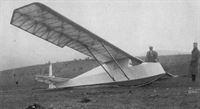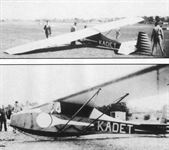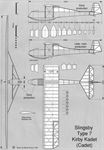
Варианты
- Schneider - Grunau Baby - 1931 - Германия
- Dart - Cambridge - 1935 - Великобритания
- Goppingen - Go.1 Wolf - 1935 - Германия
- Slingsby - T.6/T.23 Kirby Kite - 1935 - Великобритания
- Slingsby - T.7 Kirby Cadet / T.8 Kirby Tutor / T.20 / T.31 - 1936 - Великобритания
- Slingsby - T.12 / T.14 / T.15 Gull - 1938 - Великобритания
- Slingsby - T.21 Sedbergh / T.30 Prefect - 1944 - Великобритания
- Slingsby - T.29 Motor-Tutor - 1947 - Великобритания
M.Simons The World's Vintage Sailplanes 1908-45
THE KIRBY KADET AND TUTOR
The Kadet, Slingsby’s Type 7, was designed by John Stanley Sproule who joined the firm as what Slingsby called “a very good boy". He persuaded Slingsby to let him design a glider with better soaring ability than the Pruefling, with a span somewhat less than that of the Hols der Teufel, and a cleaner aerodynamic form. The new Kadet with its two-spar, parallel strutted wing, was test flown on 11th January, 1936. Over 20 were built. Kits were also exported for assembly overseas. The earliest models had straight-backed fuselages, the nose in front of the cockpit resembling that of the Pruefling, and the rudders were tall. There was no landing wheel. The weight, empty, was 118 kg, giving a low wing loading of 13 kg/sq m, hence the good light wind soaring ability with a pilot of average weight.
An order was soon received from the Midland Gliding Club for a set of improved wings for their existing Kadets. Sproule laid out a tapered wing retaining the aerofoil of the Kadet since the rib jigs for the inner panels already existed. Toward the tips he changed the profile to the same reflexed form as that used on the well-known Falke. The new glider was at first known as the Taper-wing Kadet but was soon re-christened Tutor. The practice of changing wings around does not seem to have been very common. The fuselage was modified and all Kadets and Tutors thereafter had a gracefully curved rear fuselage spine. Rudders were reduced in height, and the old-fashioned nose shape was simplified. Seven Tutors were sold before the outbreak of the Second World War.
Big developments were to follow. The Air Training Corps soon adopted the Kadet and Tutor as standard training gliders for their large, semi-military pilot training programme. Air Ministry specifications were speedily written around the two Slingsby types, and were issued. All the gliders from now on had landing wheels, were strengthened and painted in military style with dark green dope. The outer wing panels of the Tutor were simplified, giving a straight leading edge, which did not improve the appearance, but made no real difference aerodynamically. The result was a very practical, robust pair of training gliders. The names were also changed. The spelling of Kadet was evidently thought too Germanic, so it was henceforth as the Cadet Mark 1 and Cadet Mark 2 that the Kadet and Tutor were known to the ATC.
Slingsbys built 226 Cadets and other companies another 180, under the Air Ministry contracts. Six Cadets went to Canada, one to be modified and flown in post-war years as a sailplane. One was built in the USA for study as a possible trainer for the US Army glider pilot programme. It was known there as the Kadet UT (utility) 1, and first flew at Meriden, Connecticut, in May 1943. This aircraft still survives.
At the same time, 62 Tutors (Cadets. Mark 2) were built at Slingsby’s factory. All gliders now were fitted with the new OTTFUR safety release. Ottley Motors, a small family company in North London, built the releases and produced over 30 Cadets as a sideline.
Post-war, Slingsby built a few more of each and, under licence, Martin Hearn Ltd sold over two dozen of both types. Altogether, 431 of Type 7 and 106 of Type 8, were produced with a few others assembled from kits or spare parts, including one in Australia. Until the early ’60s, Tutors remained the most common ’early solo' gliders in England. A two seat version, the Type 31, was produced in 1950.
A Cadet flown by John Jeffries achieved some remarkable cross-country performances. The best, in 1960, was a distance of 260.6 km
Technical data:
Kadet: Span, 11.70 m. Wing area, 15.8 sq m. Aspect ratio, 8.66. Empty weight, 118 kg. Flying weight, 208 kg. Wing loading, 13.2 kg/sq m. Aerofoil, Goettingen 426.
Cadet Mark 1: Span, 11.73 m. Wing area, 15.8 sqm. Aspect ratio, 8.71. Empty weight, 134.5 kg. Flying weight, 232.7 kg. Wing loading. 14.07 kg/sq m.
Tutor, Cadet Mark 2: Span, 13.24 m. Wing area, 15.79 sqm. Aspect ratio, 11.1. Empty weight 159.5 kg. Flying weight. 258.5 kg. Wing loading, 16.4 kg/sq m. Best glide claimed, 1:21 at 50 km/h.
Описание:
- M.Simons The World's Vintage Sailplanes 1908-45
- M.Hardy. Gliders & Sailplanes of the world
Фотографии
-
GL / M.Simons - The World's Vintage Sailplanes 1908-45 /Kookaburra/
The Kirby Tutor just after take-off.
-
GL / M.Simons - The World's Vintage Sailplanes 1908-45 /Kookaburra/
Taken at High Wycombe in 1971, this photograph shows, left to right, the nose of a Weihe, the Cantilever Gull or Kirby Gull 3, the Dunstable-based Minimoa and at the far end of the line, the Kirby Tutor.
Другие самолёты на фотографии: DFS Weihe - Германия - 1938Goppingen Go.3 Minimoa - Германия - 1935Slingsby T.12 / T.14 / T.15 Gull - Великобритания - 1938
-
Aeroplane Monthly 1996-08 / M.Oakey - Vintage news
This open-cockpit Slingsby T.31 glider, recovered from a carpet factory in Northern Ireland, is to be restored to flying condition by the Camphill Vintage Gliding Group (CVGG), formed by the Tideswell-based Derbyshire & Lancashire Gliding Club last year to mark its 60th. anniversary. Along with a T.21, it will be put back in the air to “give a new generation of pilots the thrill of flying with the wind in their hair”, says the CVGG. It is hoped that both aircraft will also be used in the club’s programme to give members of the public trial lessons over the Peak District countryside. The CVGG is interested in hearing from airframe fitters, aeromodellers or woodworkers who would like to help in the restorations - contact Ian Dunkley via the club on 01298 871270.
-
Aeroplane Monthly 1993-02 / M.Simons - Sling's sailplanes (7)
The prototype Kadet showing the straight-backed, fuselage, with raked nost and tall rudder. The glider was finished in clear dope and varnish all over.
-
Aeroplane Monthly 1993-02 / M.Simons - Sling's sailplanes (7)
Регистрационный номер: PD628 [2] PD628 was an early version of the Kirby Kadet, with straight fuselage back and no wheel. Inscribed County Borough of Merthyr Wing, this example is in ATC colours.
-
Aeroplane Monthly 1993-02 / M.Simons - Sling's sailplanes (7)
Регистрационный номер: PD628 [2] This view of the ATC Kadet PD628 clearly shows the camouflage pattern on the glider’s surfaces.
-
GL / M.Simons - The World's Vintage Sailplanes 1908-45 /Kookaburra/
Регистрационный номер: N30442 The American Cadet UT 1, straight backed, wheelless, and still airworthy. The owner at time of publication was Tom Smith.
-
Aeroplane Monthly 1993-02 / M.Simons - Sling's sailplanes (7)
Регистрационный номер: VM637 RAF Kirby Cadet VM637. This Mk II glider is pictured in October 1946. The wire bracing between the lift struts is clearly visible.
-
Aeroplane Monthly 1993-02 / M.Simons - Sling's sailplanes (7)
Two views of the Australian Kadet, imported as a kit in 1939 by members of the Gliding Club of Victoria. It first flew in January 1941 and still survives in Adelaide, but is not airworthy. Note the tall rudder, the absence of a landing wheel and the later type of fuselage.
-
Aeroplane Monthly 1988-10 / P.Cooksley - RAF Kenley. Bulwark of London (2)
Регистрационный номер: XA301 Kirby Cadet XA301 of the ATC school at Kenley, in 1972. The Cadets were later replaced with Sedbergh gliders.
-
GL / M.Simons - The World's Vintage Sailplanes 1908-45 /Kookaburra/
A pre-war wheelless Kadet in flight.
-
GL / M.Simons - The World's Vintage Sailplanes 1908-45 /Kookaburra/
The prototype Tutor in post-war garb at Long Mynd.
-
Aeroplane Monthly 1987-04 / M.Hardy - Redhill recollections (1)
Регистрационный номер: G-ALKB Slingsby T.8 Tutor G-ALKB of the North Downs Gliding Trust, seen at Redhill devoid of its registration letters.
-
Aeroplane Monthly 1993-03 / M.Simons - Sling's sailplanes (8)
Регистрационный номер: G-ALTU Built by D. C. Burgoyne as a Type 7 Cadet, BGA No 657 was brought up to Type 8 standard and is seen here bearing the civil registration G-ALTU, acquired for a short period in 1950.
-
Aeroplane Monthly 1993-03 / M.Simons - Sling's sailplanes (8)
A post-war Tutor built by Martin Hearn Ltd. The blue stripes of the Derbyshire & Lancashire Gliding Club may be seen on the rudder.
-
Aeroplane Monthly 1993-03 / M.Simons - Sling's sailplanes (8)
The "taper-wing" Kadet flown at Dunstable in 1938 by Philip Wills.
A pre-war Tutor with wing leading edge taper and no wheel. -
Aeroplane Monthly 1993-03 / M.Simons - Sling's sailplanes (8)
A Tutor flying at Sutton Bank.
-
Aeroplane Monthly 1993-03 / M.Simons - Sling's sailplanes (8)
Регистрационный номер: VM364 RAF TX Mk 2 Cadet VM634. Note the straight leading edge, the only external visible difference between the Mk 2 wing and that of the Taper-wing Kadet.
-
GL 1982- / M.Hardy - Motor Gliders /Gliders & Sailplanes of the world/ (2)
Регистрационный номер: G-AXMB Slingsby/Osborne Twin Cadet.
-
Aeroplane Monthly 1977-02 / J.Sproule - Carrier-borne glider
John Sproule prepares to rise to the occasion during the first "air-wake" investigations aboard HMS Pretoria Castle in May 1945. At this time the Type 20 was suitably camouflaged, but it was later doped silver overall.
-
Aeroplane Monthly 1977-02 / J.Sproule - Carrier-borne glider
Picture shows the author aloft in the Slingsby Type 20 over HMS Illustrious on October 19, 1949, during the second series of experiments. The first tests had taken place over four years earlier.
-
Aeroplane Monthly 1977-02 / J.Sproule - Carrier-borne glider
The T.20 well clear and ready to rise.
-
Aeroplane Monthly 1977-02 / J.Sproule - Carrier-borne glider
During the 1949 trials, with the enormous fixed flaps in evidence.
-
Aeroplane Monthly 1977-02 / J.Sproule - Carrier-borne glider
Manhandled to a touchdown.
-
Aeroplane Monthly 1977-02 / J.Sproule - Carrier-borne glider
Lt Curry, RN, disappears below deck level, the T.20's wing tip scraping down the side of Illustrious as it descends into the sea on its last flight. The radio mast in which the tow cable became tangled can be seen immediately in front of the glider.
-
Aeroplane Monthly 1986-11 / A.Welch - Vintage gliders galore
The Slingsby T.31 has a new lease of life note that it has become vintage. Although its performance as a school glider was something of a joke, the care taken by new owners to remove old paint and improve the finish enables the T.31s to stay up much better.
-
Aeroplane Monthly 1993-02 / M.Simons - Sling's sailplanes (7)
Slingsby Type 7 Kirby Kadet (Cadet)
-
Aeroplane Monthly 1993-03 / M.Simons - Sling's sailplanes (8)
Slingsby Type 8 Kirby Tutor
- Фотографии




























